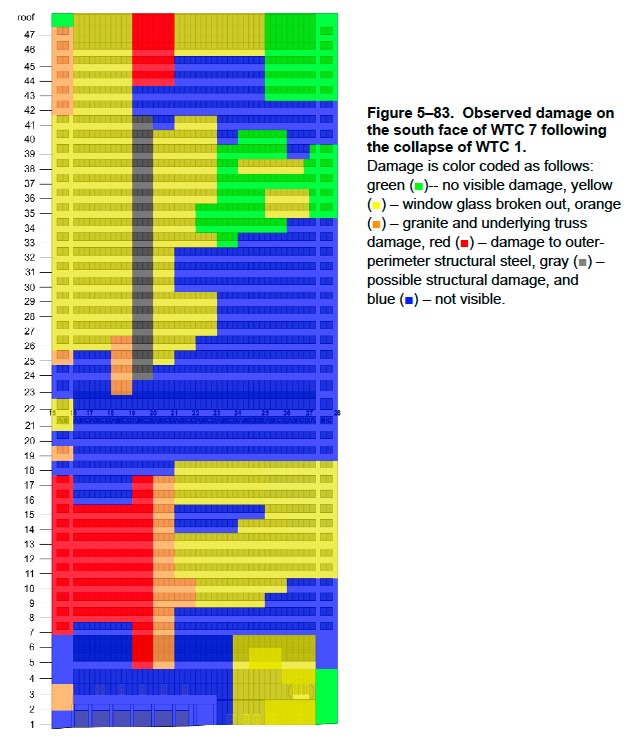...common arguments for the controlled demolition of 7 has been based on the observation that its downward acceleration approximated that of a free-falling object. This could have happened, critics of the official account have pointed out, only if explosives of some sort had removed all of the buildings structural columns. Otherwise, even if the upper part of the building had started to come down, the lower part would have stopped or at least slowed down its descent.
NIST's Draft for Public Comment: In its Draft for Public Comment, which was issued on August 21, 2008, NIST countered this argument by claiming that the time that it took WTC 7 to collapse shows that it was not falling freely. NIST wrote:
The time the roof line took to fall 18 stories was 5.4 s[econds].... Thus, the actual time for the upper 18 floors of the north face to (Apse, based on video evidence, was approximately 40 percent longer than the computed free fall time and was consistent with physical principles.
6) NIST repeated this claim in a Q and A document ("Questions and Answers about the NIST WTC 7 Investigation"), which was issued the same day as the Draft Report.
One of the questions was: in videos, it appears that WTC 7 is descending in free fall, something that would not occur in the structural collapse that you describe. How can you ignore basic laws of physics?
NIST gave the following answer (in a document that has since been removed from its website):
WTC 7 did not enter free fall. According to NIST analysis of WTC 7 video, the building collapsed 18 stories in 5.3 seconds [sic: NIST usually said 5.4 seconds]. if the building exhibited free fall, this " would have taken just 3.9 seconds. The actual collapse time exceeded the free fall time by 40 percent."
To say "the actual collapse time exceeded free fall time by 40 percent" was to say that the building's acceleration was only 51 percent of that of gravity. Even that would have been an incredibly fast descent in a fire-induced collapse (if such were possible). But by saying that the building's acceleration was only 51 percent of that of a free-falling object, NIST was at least able to contradict the widespread claim that it had come down in free fall.
In his technical briefing on August 26, 2008, NIST's lead investigator, Shyam Sunder, explained why WTC 7 could not have come down in free fall:
[A] free fall time would be an object that has no structural components below it.... What the... collapse analysis shows, is that same time [sic] that it took for the structural model to come down from the roof line all the way—for those 17 floors to disappear--is 5.4 seconds. It's about 1.5 seconds, or roughly 40 percent, more time for that free fall to happen [sic]. And that is not at all unusual, because there was structural resistance that was provided in this particular case. And you had a sequence of structural failures that had to take place. Everything was not instantaneous.
Sunder thereby summarized the two main reasons even if he did not clearly distinguish between them—why NIST could not endorse the idea that WTC 7 had come down in free fall. (1) The upper floors could not have come down in free fall, because that could have happened only if nothing of the lower floors had remained to provide structural resistance. And (2) the collapse could not have been "instantaneous," meaning that all of the supporting columns had failed simultaneously, because NIST espoused a theory of "progressive collapse," in which the failures occurred sequentially over a period of time.
David Chandler's Response to MST's Draft Report: Sunder's statement at the technical briefing, quoted above, was made in response to the following question from high-school physics teacher David Chandler:
Any number of competent measurements using a variety of methods indicate the northwest corner of WTC 7 fell with an acceleration within a few percent of the acceleration of gravity. Yet your report contradicts this, claiming 40 percent slower than free can such a publicly visible, easily measurable quantity be set aside.6'
[Skipping ahead...] [....]
NIST'S Final Report on WTC 7: In its final Report, NIST still uses the early start time, thereby claiming that the upper 18 floors took 5.4 seconds to collapse. It also continues to use the average descent rate. NIST can thereby continue saying that the building took 40 percent lon than free-fall time to collapse. All of these elements are contained in the following summary statement:
The time that the roofline took to fall 18 stories... was approximately 5.4 s[econds]. The theoretical time for free fall was approximately 3.9 s[econds]. Thus, the average time for the upper 18 stories to collapse, based on video evidence,.., was approximately 40 percent longer than the computed free fall time.
Within this unchanged framework, however, NIST goes beyond its former approach by dividing this 5.4-second period into three stages, in which it acknowledges the point on which Chandler had been insisting. After repeating the claim that the descent time of the upper 18 stories "was 40 percent greater than the computed free fall time," NIST says on page 607 of the long version of its Final Report:
A more detailed analysis of the descent of the north face found three stages: (1) a slow descent with acceleration less than that of gravity that corresponded to the buckling of the exterior columns at the lower floors, (2) a free-fall descent over approximately eight stories at gravitational acceleration for approximately 2.25 s[econds], and (3) a decreasing acceleration as the north face encountered resistance from the structure below.77 Although this is stated matter-of-factly, as if nothing extraordinary were being said, NIST's three-phase analysis includes, in Chandlers words, "a whopping 2.25 seconds of absolute free fall."
NIST has thereby contradicted its claim.... that "WTC 7 did not enter free fall." It now acknowledges that WTC 7 not only entered free fall but remained in it for 2.25 seconds which means that, for over two lower floors of the building were offering
zero resistance.
NIST also admits this point in an updated version of its Q & A.... This is, of course, exactly what Sunder in his technical briefing of August 2008 had said could
not have occurred.











